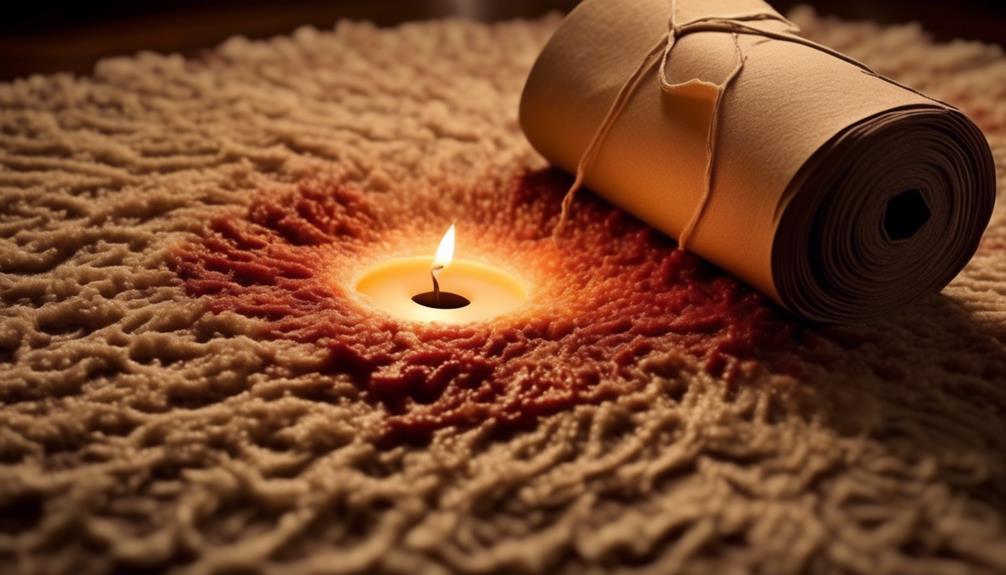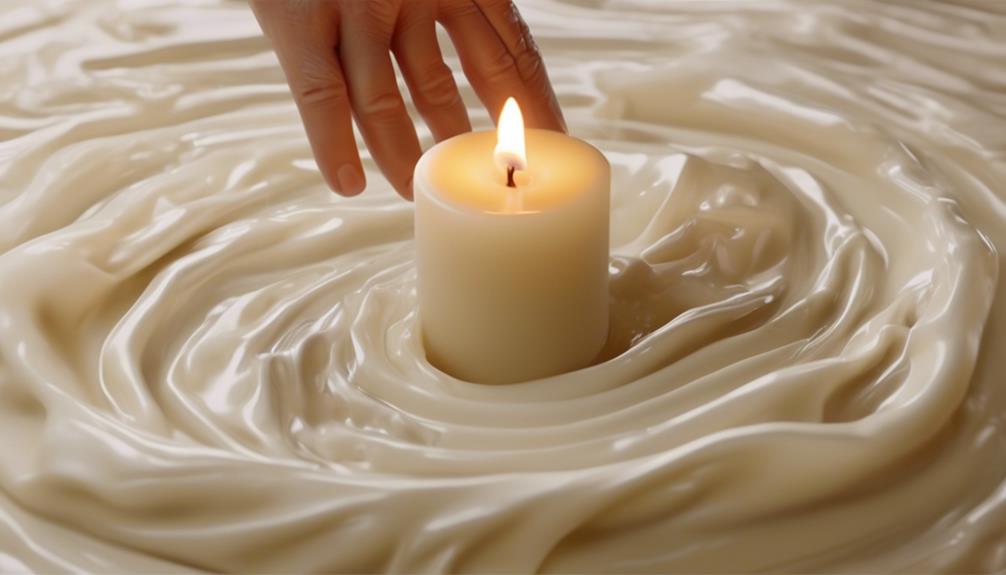Have you ever enjoyed a cozy night with candlelight and then oops! Got wax on your carpet? Don’t panic! **There are smart tricks** to easily clean up this usual home accident. Curious to find out how? Continue reading to discover the secrets!
From freezing the wax to using heat and absorption techniques, we've got you covered.
But what happens if the wax seeps deep into the fibers of the carpet, making removal a real challenge?
Stay tuned as we unravel the secrets to successfully removing candle wax from your carpet, leaving it spotless once again.
Key Takeaways
- Gather necessary materials and prepare the area before starting the wax removal process.
- Freeze and scrape off the hardened wax, then apply heat to soften and blot the residue.
- Use an iron or hair dryer to melt and transfer the wax onto a cloth or towel.
- Consider professional cleaning services for thorough wax removal and to prevent carpet damage.
Gather Necessary Materials
To effectively gather the necessary materials for removing candle wax from carpet, ensure you have a clean white cloth or paper towels on hand. These will be crucial for absorbing the melted wax.
Additionally, have a plastic bag and an iron ready. The plastic bag will aid in freezing the wax for easier removal, while the iron will help in melting and transferring the wax onto the white cloth or paper towels.
It's essential to act quickly when dealing with wax on carpet to prevent it from solidifying further. By having these materials prepared and within reach, you can tackle the issue promptly and efficiently.
Freeze the Wax
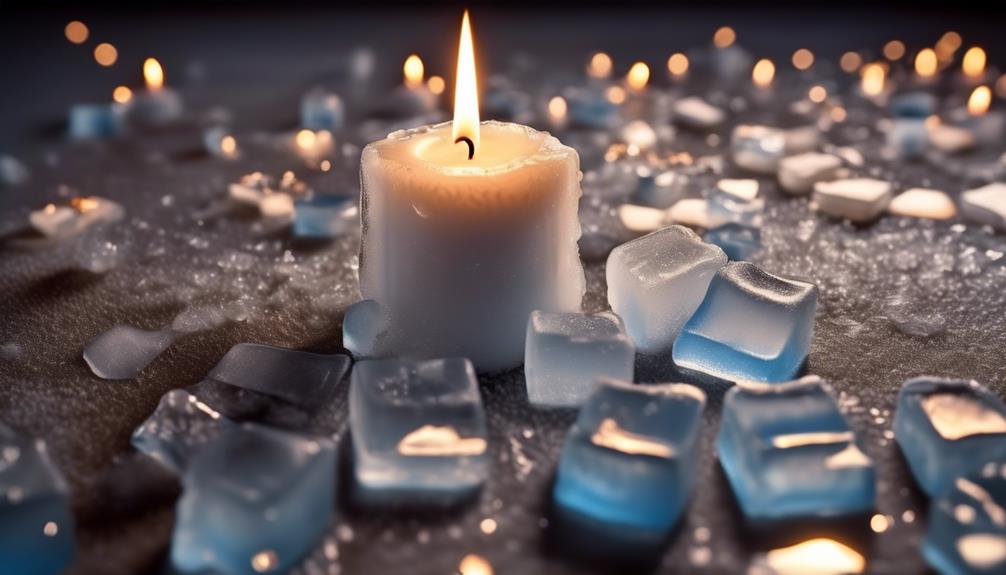
We can initiate the process of freezing the wax by carefully placing a plastic bag filled with ice cubes or an ice pack over the affected area on the carpet. The cold temperature from the ice will cause the wax to freeze and harden, making it easier to remove from the carpet fibers. Leave the ice or ice pack on the wax for about 15-20 minutes to ensure that the wax is thoroughly frozen.
Once the wax has hardened, use a butter knife or a credit card to gently scrape off the frozen wax from the carpet. Be cautious not to damage the carpet fibers while doing this. You may need to repeat the freezing process with fresh ice or an ice pack if the wax doesn't come off completely in one go.
After removing the frozen wax, you can follow up with the cleaning process to eliminate any residual wax. Remember to dispose of the wax and cleaning materials properly. Make sure the carpet is completely dry before using it again to prevent any damage.
Scrape off the Hardened Wax
Let's begin by scraping off the excess hardened wax from the carpet using a dull knife or a plastic card.
Apply a heat source over a paper towel on the wax to soften it, making it easier to remove.
Once softened, blot the area with a clean cloth to lift the wax residue off the carpet fibers effectively.
Scrape off Excess Wax
Gently scrape off the hardened wax from the carpet using a butter knife or a similar tool designed for this purpose. Start at the edges of the wax spill and work your way towards the center to prevent spreading the wax further. Apply gentle pressure to lift the wax without damaging the carpet fibers. Be cautious not to rub the wax into the carpet as this can embed it deeper.
Once you've scraped off as much wax as possible, vacuum the area to remove any remaining particles and fluff up the carpet fibers. Repeat the vacuuming process if necessary to ensure all debris is removed.
Inspect the carpet to ensure the wax stain is completely gone.
Apply Heat Source
After scraping off the hardened wax from the carpet, the next step involves applying a heat source to soften the residue for easier removal. Here's how to effectively use a heat source:
- Iron Over a Towel: Place a clean towel over the wax residue and run a warm iron over it. The heat will melt the wax, allowing it to transfer onto the towel.
- Hair Dryer Method: Use a hair dryer on a medium setting to warm up the wax. Once softened, gently blot the area with a clean cloth to absorb the wax.
- Repeat if Necessary: If there's still wax remaining, repeat the heating process until the carpet is wax-free.
- Ensure Complete Removal: Repeat the cleaning process if needed to ensure all wax and stains are completely gone.
Blot With Cloth
To effectively remove hardened wax from the carpet, begin by gently scraping off the residue with a blunt tool. Once you have removed as much of the hardened wax as possible, it's time to tackle any remaining wax that may have seeped into the carpet fibers.
Grab a clean white cloth or paper towel, place it over the affected area, and apply a warm iron on top. The heat will help melt the wax, allowing it to transfer onto the cloth. Remember to use a fresh section of the cloth or paper towel as needed to prevent re-depositing the spilled candle wax back onto the carpet.
Continue this process until no more wax transfers onto the cloth, ensuring a thorough removal.
Heat and Absorb Residual Wax
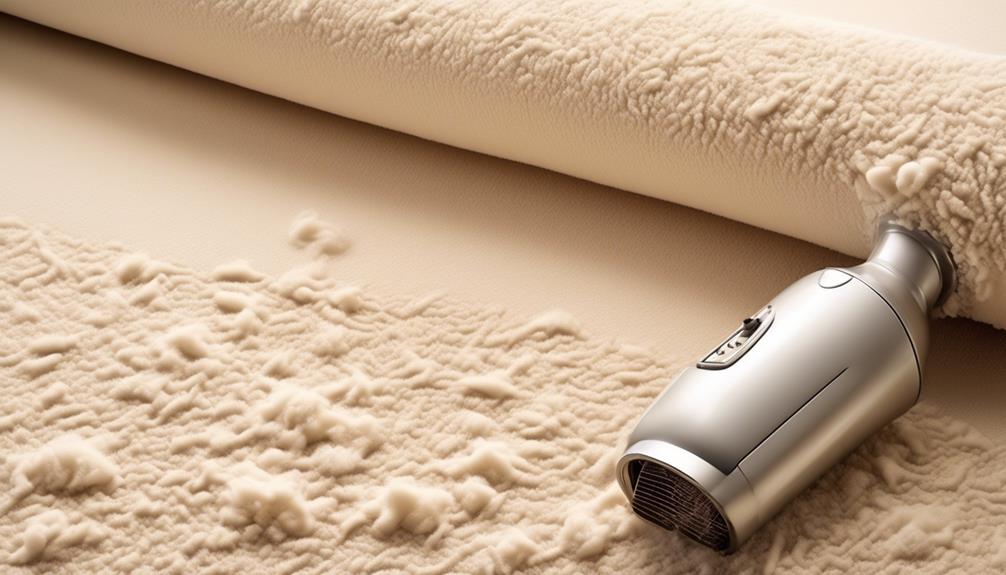
Utilizing a hairdryer or iron can effectively heat and absorb any residual wax trapped in the carpet fibers. When dealing with melted wax on your carpet, it's crucial to follow these steps to ensure thorough removal:
- Apply Heat: Use a hairdryer or an iron on a low setting with a paper towel or cloth over the wax. The heat will help melt the wax, making it easier to absorb.
- Absorb Residual Wax: Place a clean paper towel or cloth over the melted wax and gently press down. The cloth will absorb the wax as it melts, lifting it from the carpet fibers.
- Repeat if Needed: If there's still wax remaining, repeat the process until the wax is fully absorbed. Be patient and avoid using excessive heat to prevent damaging the carpet.
- Final Clean-Up: Once the wax is removed, use a carpet cleaner to clean any remaining residue and ensure your carpet looks good as new. If stubborn stains persist, consider seeking professional cleaning services for larger areas or tough stains.
Iron the Affected Carpet Area
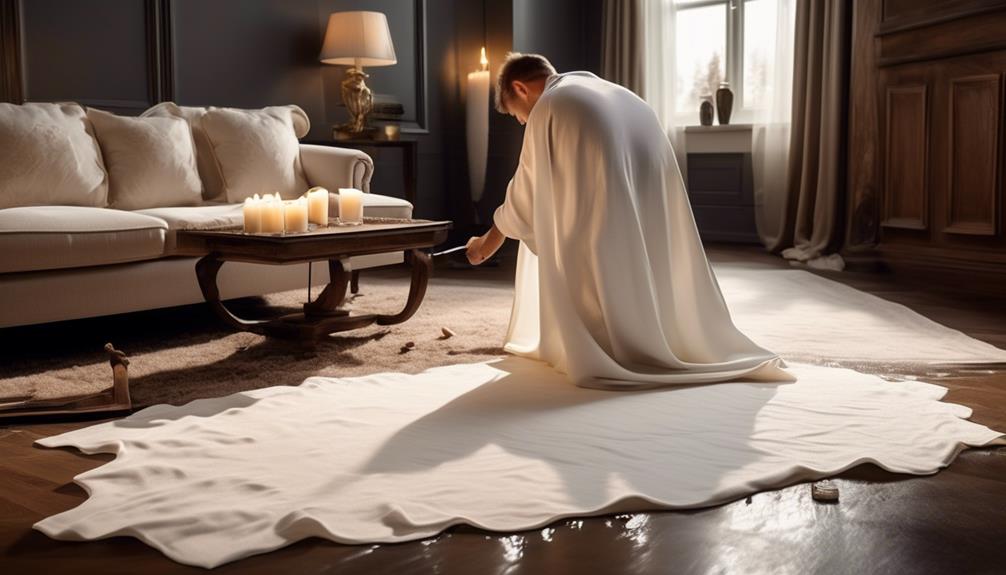
With the right technique and caution, using an iron can effectively remove candle wax from carpet fibers.
To begin, ensure the wax is frozen by placing ice in a plastic bag over the affected area. Once frozen, carefully scrape as much of the hardened wax off the carpet as possible using a butter knife or a credit card.
Next, place a paper towel or brown paper bag over the remaining wax. Set your iron to a low heat setting and gently iron over the paper, allowing the heat to melt the wax. The melted wax will be absorbed by the paper towel or bag. Remember not to apply too much heat or press too hard to prevent damage to the carpet fibers.
Repeat the process with a clean portion of the paper until all the wax is removed. Finally, clean the area with a carpet cleaner or rubbing alcohol to eliminate any leftover residue.
Apply Carpet Cleaner Solution
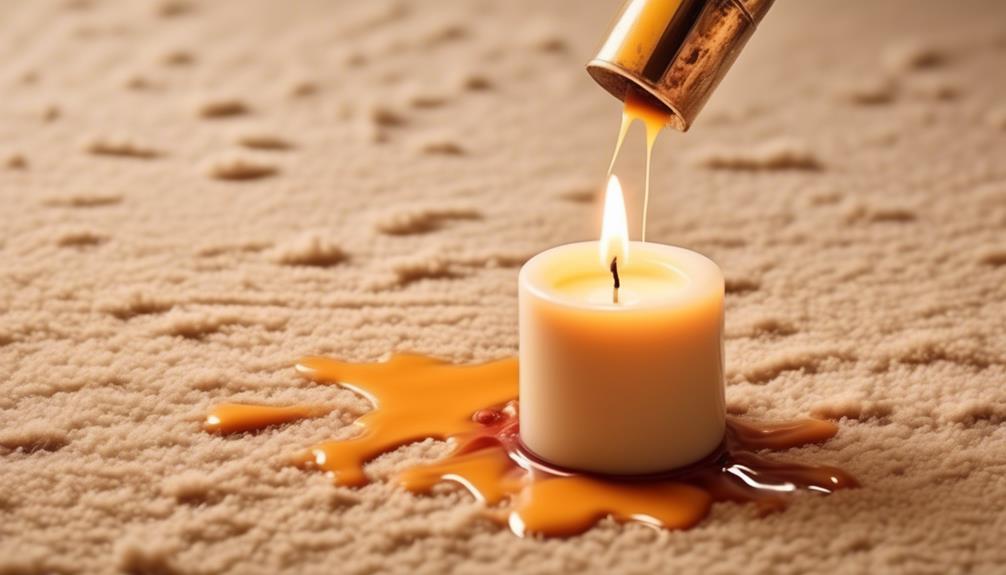
Wondering how to effectively apply a carpet cleaner solution to remove any remaining wax residue from the carpet fibers? When it comes to cleaning up candle wax from your carpet, using a carpet cleaner solution can be a game-changer. Here's how to tackle this task like a pro:
- Choose the Right Cleaner: Opt for a carpet cleaner specifically designed to clean white carpets and remove tough stains like wax.
- Spot Test First: Before applying the cleaner to the affected area, always do a spot test in an inconspicuous area to ensure it won't damage or discolor your carpet.
- Apply the Solution: Follow the manufacturer's instructions on how to apply the carpet cleaner. Typically, you'll spray the solution onto the wax residue and let it sit for a few minutes to penetrate the fibers.
- Blot and Repeat if Necessary: Use a clean white cloth to blot the area gently. If there's still wax residue remaining, repeat the application process until the carpet is wax-free.
Blot and Lift Remaining Residue
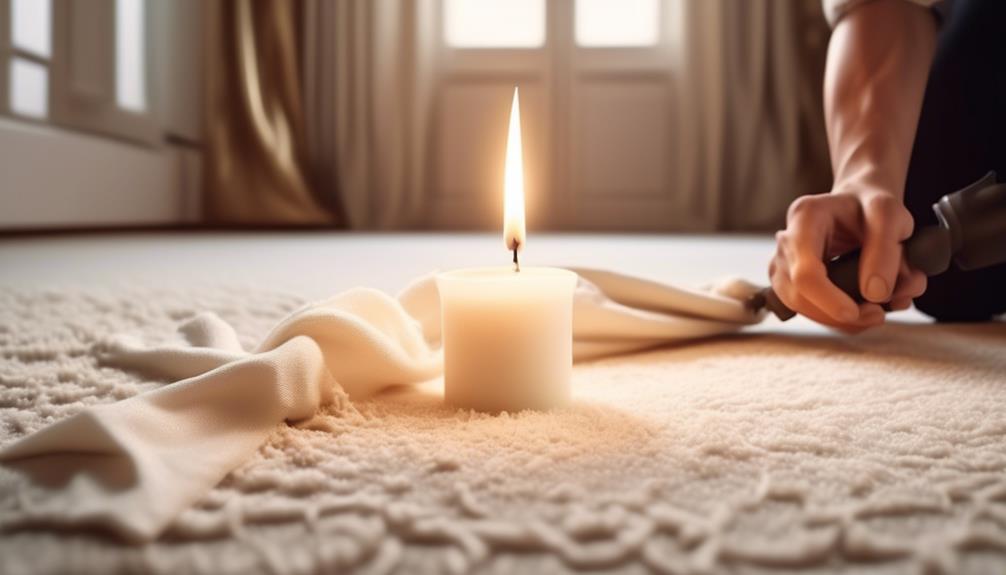
Once the wax residue has been treated with a carpet cleaner solution, the next step is to meticulously blot and lift any remaining residue from the carpet fibers. To effectively remove the wax stain, start by blotting the area with a clean white cloth. Press down firmly to absorb as much of the remaining wax as possible. Continue this process, using a fresh section of the cloth as needed, until no more wax transfers onto the cloth.
After the majority of the wax has been lifted, focus on the lingering residue. You can use rubbing alcohol on a clean cloth to help dissolve and lift any stubborn wax remnants. Gently dab at the area, ensuring not to scrub vigorously as this can damage the carpet fibers. Repeat the blotting process until the carpet is free from any visible residue and feels dry to the touch.
Use a Vacuum to Clean up
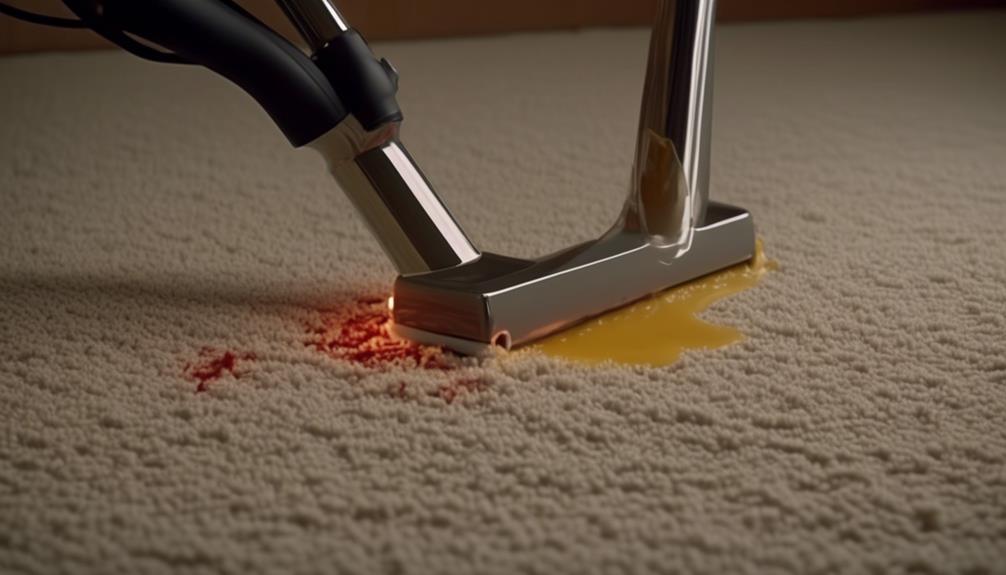
Let's tackle the next step in cleaning candle wax from the carpet by using a vacuum.
Grab a vacuum cleaner with a hose attachment and carefully suck up any loose wax particles.
Make sure to move the vacuum slowly and deliberately to effectively clean the affected area.
Vacuum up Loose Wax
To effectively remove loose wax from the carpet, we recommend using a vacuum with an upholstery brush attachment to ensure thorough cleaning and restoration of the carpet fibers.
Here's a step-by-step guide to vacuum up loose wax:
- Prepare the Vacuum: Attach the upholstery brush to the vacuum nozzle for gentle but effective cleaning.
- Set the Vacuum: Adjust the vacuum settings to a suitable level for cleaning the carpet without causing damage.
- Vacuum the Area: Slowly pass the vacuum over the wax spill, ensuring the suction picks up loose wax particles.
- Inspect and Repeat: Check the area for any remaining wax. If needed, repeat the vacuuming process until the carpet is free of wax residue.
Use Cold Method
When dealing with candle wax on carpet, employing the cold method and utilizing a vacuum for cleanup is a practical approach to effectively address the issue. To start, place an ice pack or ice cubes in a plastic bag on top of the wax to harden it. Once the wax is frozen, carefully scrape off excess wax with a butter knife or credit card. Next, lay a clean towel on top of the wax and run a heated iron over the towel. The remaining wax will transfer to the towel due to the heat, leaving the carpet clean. Finally, vacuum up any residual wax particles for a pristine finish.
| Steps | Details | Tips |
|---|---|---|
| Freeze the Wax | Place ice or an ice pack on the wax to harden it. | Ensure the wax is completely frozen. |
| Scrape the Wax | Gently scrape off the frozen wax using a knife or card. | Be careful not to damage the carpet. |
| Heat and Absorb | Cover the wax with a towel and iron over it to transfer the wax onto the towel. | Use a low heat setting on the iron. |
| Vacuum Residue | Use a vacuum to clean up any remaining wax particles. | Test the vacuum on a small area first. |
| Final Inspection | Check the carpet for any leftover wax residue and repeat the process if necessary. | Avoid using colored towels to prevent staining. |
Repeat Steps if Needed
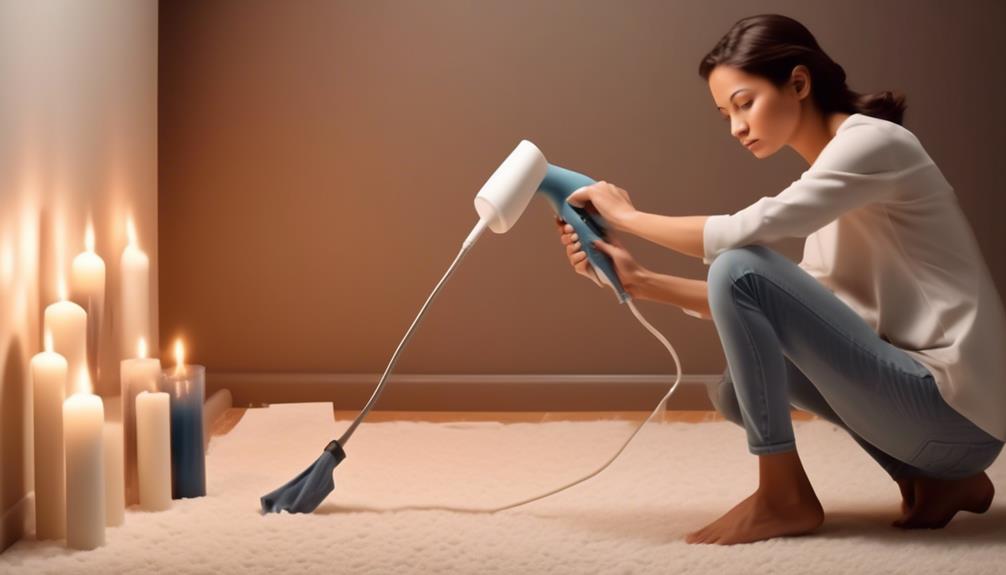
If additional residue persists, it may be necessary to repeat the cleaning process to ensure thorough removal of wax from the carpet. Here are some steps to consider if you need to repeat the process:
- Scrape Off Excess Wax: Before applying any cleaner or rubbing the area again, ensure that you have removed any remaining wax drips on the carpet surface. Use a butter knife or credit card to gently scrape off the excess wax.
- Apply Cleaner: Reapply the carpet cleaner or rubbing alcohol to the affected area. Let it sit for a few minutes to penetrate and loosen any stubborn wax residue.
- Rub the Area: Using a clean cloth or sponge, gently rub the area in a circular motion. Apply light pressure to lift off the remaining wax from the carpet fibers.
- Repeat if Necessary: If there are still traces of wax on the carpet after the first repeat, consider going through the steps again until the carpet is completely free from wax residue.
Consider Professional Cleaning Services
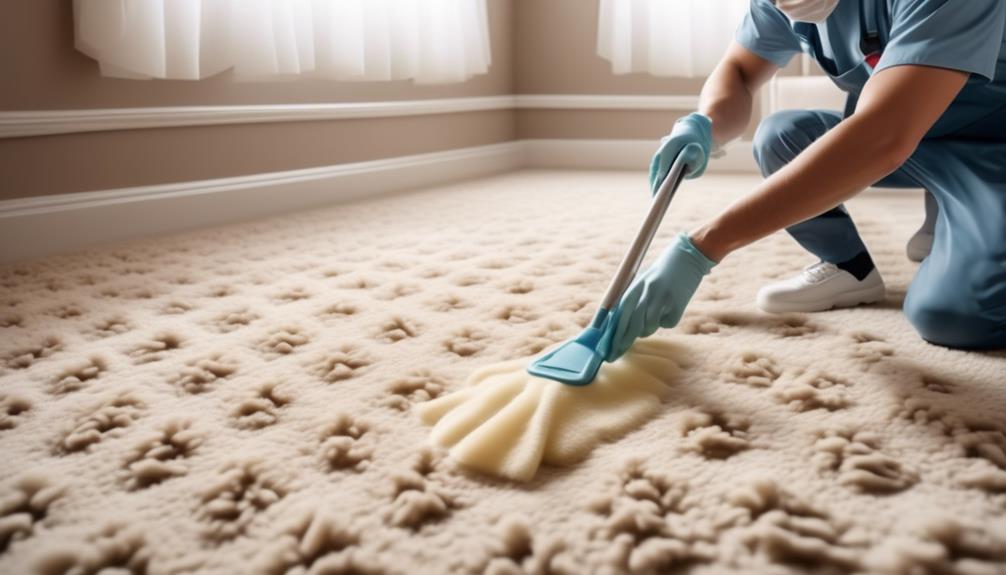
When tackling tough wax stains on carpets that seem resistant to removal, considering professional cleaning services can be a wise choice.
Professional cleaners possess the necessary tools and skills to tackle even the most stubborn wax stains effectively.
Entrusting the task to experts can ensure a thorough cleaning process that restores your carpet to its original condition.
Professional Carpet Cleaning
Considering professional cleaning services can greatly enhance the effectiveness of removing tough candle wax stains from your carpet. Here are some reasons why opting for a professional carpet cleaner is a wise choice:
- Specialized Equipment: Professionals have the right tools to extract wax out of carpet fibers effectively.
- Expertise and Experience: Experienced carpet cleaners know the best techniques to tackle wax stains without damaging the carpet.
- Tailored Solutions: They can provide customized solutions based on the carpet material and the severity of the wax spill.
- Deep Cleaning: Professional carpet cleaning goes beyond surface-level removal, ensuring a thorough clean that eliminates any remnants of wax.
When it comes to getting Wax Out of Carpet, entrusting the task to a professional carpet cleaning service can yield exceptional results.
Expert Wax Removal
Professional cleaning services are essential for expert wax removal from carpets, ensuring thorough and effective results. When dealing with stubborn wax stains, professional cleaners have specialized cleaning solutions and tools such as rubbing alcohol to dissolve the wax effectively. They use techniques like gently scraping with a butter knife to lift the wax without damaging the carpet fibers.
These experts can ensure that the carpet is meticulously cleaned and free from any residue, leaving it looking as good as new. Hiring a professional cleaner not only saves time but also prevents any potential damage that may occur when attempting to remove wax without the proper knowledge and equipment.
For the best results and to maintain the quality of your carpet, consider consulting local professional cleaning services that specialize in wax removal.
Professional Restoration Services
For thorough cleaning and effective removal of tough wax stains from carpets, utilizing professional restoration services is highly recommended. When considering professional cleaning services, keep in mind the following benefits:
- Specialized Equipment: Professionals have the right tools to tackle stubborn wax stains.
- Expertise in Stain Removal: Their experience ensures proper removal without damaging carpet fibers.
- Thorough Cleaning: Professionals can ensure that no residue or stain is left behind.
- Time and Effort Saving: Hiring experts saves you from the hassle of DIY methods and guarantees a job well done.
Tips for Preventing Future Wax Spills
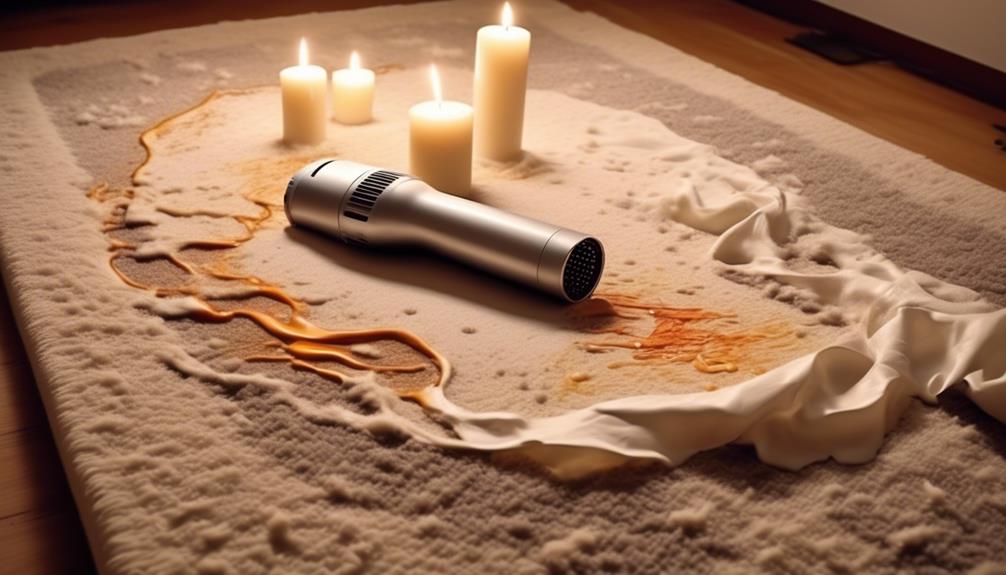
To prevent future wax spills, it's essential to utilize candle holders or trays to catch any dripping wax. Placing a heat-resistant mat or cloth underneath candles can further protect surfaces from any potential damage caused by melted wax. Additionally, it's crucial to keep candles away from drafts or areas where they can easily be knocked over to prevent accidents. Regularly trimming candle wicks to ¼ inch can help control flame size and limit excessive wax melting, reducing the risk of spills. For those seeking a safer alternative, consider using flameless LED candles instead.
In the event of a wax spill, quick action can prevent further damage. Use a paper towel to gently blot up excess wax, being careful not to spread it further. Then, gently scrape off any remaining residue with a butter knife. Finally, place a piece of brown paper over the affected area and carefully iron over it on a low setting to absorb any remaining wax.
Frequently Asked Questions
How Do I Remove Candle Wax From Carpet?
We remove candle wax from carpet using the following steps:
- Freeze the wax with ice.
- Scrape off the frozen wax with a knife.
- Use an iron or hair dryer to apply heat and melt the remaining wax.
- Absorb the melted wax with a paper towel or brown paper bag.
- Clean the carpet with a carpet cleaner or rubbing alcohol to eliminate any stains.
- Restore the carpet's texture by vacuuming to remove any leftover particles.
Does Vinegar Get Candle Wax Out of Carpet?
Yes, vinegar can effectively remove candle wax from carpet. It works by breaking down the wax, making it easier to lift off the fibers.
Simply apply a mixture of vinegar and water, let it sit, then gently scrape or blot the wax away. Repeat if needed and ensure the carpet is completely dry before use.
Regular maintenance will prevent future stains. So, vinegar is a great option for tackling candle wax on carpets.
What Is the Easiest Way to Remove Candle Wax From the Floor?
The easiest way to remove candle wax from the floor is by using a few simple steps.
First, you'll want to let the wax harden completely. Then, gently scrape off as much wax as possible using a plastic scraper or a credit card.
Next, place a paper towel over the remaining wax and use a warm iron to melt the wax into the paper towel. Finally, repeat this process until all the wax is removed.
What Removes Spilled Candle Wax?
Removing spilled candle wax is like peeling off a band-aid—gently but with purpose.
First, grab a plastic bag and ice cubes. Place the bag of ice on the wax to harden it.
Then, carefully scrape off the hardened wax using a butter knife or credit card.
Next, blot the area with a cloth soaked in a mixture of dish soap and warm water.
Repeat until the wax is gone, and voilà, a clean carpet!
Conclusion
In conclusion, removing candle wax from carpet can be a simple process with the right tools and techniques.
By freezing, scraping, heating, and ironing the affected area, you can effectively get rid of the stubborn wax stains.
Remember to vacuum the carpet thoroughly afterwards and consider seeking professional cleaning services if needed.
With these tips in mind, you'll be able to tackle any wax spills with ease.
Isn't it satisfying to see your carpet looking good as new again?
